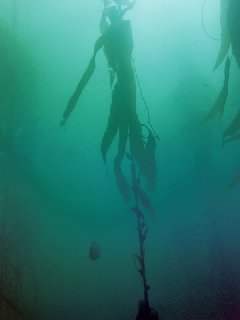
An inquiry to the D2D message board got some encouraging responses, so I made a reservation at Pt. Lobos State Park for 22-Oct-2001. One of the helpful responses was from fosterrj (Robert Foster), who indicated he might be able to dive with me. This was a good thing, as I was a bit cautious of combining a beach entry with surge, winding myself around a kelp stalk, and pretty cold water all in the same dive. All of the photos in this report were taken by Robert.
As the time approached, Robert told me about the variability of conditions from one day to the next. Fall is supposed to be a good time to dive here, as the water is generally clearer. But it can be blown out at any time depending on what's coming in from offshore. So we had a kind of vague, flexible plan. He also told me to expect low 50's temperatures. I've dove in coldish water before, fresh water around my home here in Montana, and figured I could deal with it. But coldish for me was low 60's, with an occasional quick foray into 45-55 and then back to 60's; not any sustained temperatures below 60. So I packed all the neoprene I had. It wasn't enough, but I still had fun.
For the record, I was wearing a 5mm Ocean Reef full suit, 3mm Ocean Reef hooded vest, 3mm beanie on top of the vest hood, 3mm gloves, and wool socks under my 2-3mm booties.
We were diving on a weekday, and decided that in order to avoid the worst of the commuter traffic, we would drive down to Monterey the night before. We spent the night at the Monterey Hostel. It was inexpensive ($22 each), and worked out fine.
The day dawned foggy, as expected. After breakfast at a local french bakery, we drove out to Whaler's Cove in Pt. Lobos park. We were surprised to discover that there were 13 out of 15 dive teams signed up for the day; usually it is pretty empty during the week. By the time we got there, the sun was burning off the fog. There was a bit of a swell coming in, but conditions looked pretty ideal to my untrained eye. We decided to do the Middle Reef, an easy dive and good place for me to get acclimated. We geared up, eased into the water, did an easy surface swim out, then dropped down.
Wow! What a different world. We entered a forest of giant kelp.

When I rolled over and looked up at the sun shining down, it reminded me of pictures taken in a coniferous forest, where the photographer shoots from the forest floor looking straight up. What you see is the trunks of many trees, with a canopy of leaves overhead, and the sun sparkling through the top. Only in this case the trunks were the stalks of giant kelp, with small snails clinging here and there, and leaves spreading mostly on the surface above.
The kelp stalks weren't nearly as thick as I had imagined they would be from reading, and it was magical weaving through them as we worked our way out the reef and back. I had read enough about diving in kelp to be prepared for the inevitable snags, and managed to extricate myself without too much concern and wild thrashing.
Here are a few images of what we saw (an Anemone, a closed Rose Anemone, a Copper Rockfish with some Nudibranchs, a Keyhole Limpett, a Leather Starfish, an Orange Puffball sponge, a Rose Anemone and Cobalt Sponge, a Vermillion Rockfish, and a Gum Boot Chiton).
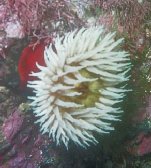
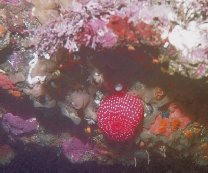
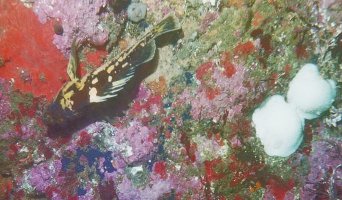

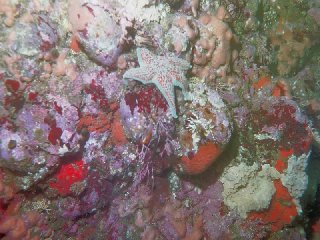



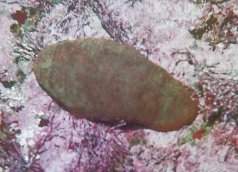
I was surprised at the amount of swell. In other situations, after I get down below about 20 feet the swell seems to be pretty much gone, but in this case it was very much in evidence still at 30 feet. Our deepest spot was 49 feet, and we were down for about an hour. Visibility was 20-30 feet. By the time we came up, I was cold. Definitely not enough neoprene. It took me quite a while to get the fingers working fully again.
While I had really enjoyed that first dive, I wasn't sure I wanted to do another one, due to the cold. I decided to reserve judgement until we had a chance to warm up. We went back to the dive shop where I had rented my tank, left our tanks to be filled, had a bite to eat, and poked around the photo shop next door. At the dive shop we inquired about some Metridium fields which were out in the bay off McAbee beach, by the breakwater where the shop was located. We got some good navigational instructions, and decided to go find them.
For this dive we surface swam out past the kelp, then dropped down and headed off on a compass bearing. Visibility wasn't nearly as good as the previous dive, more like 15 feet. Although I'd never seen a Metridium or even a picture of one that I knew of, they were easy enough to identify when we came to them. They were about 16" tall, with stalks several inches in diameter and heads six inches or so across. I kept expecting Alice or the Mad Hatter to show up.
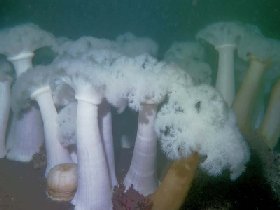
We continued on, and discovered quite a few Molas, about 18" long and 14" tall, lying on the bottom covered with Bat Starfish. The Molas weren't dead, as their pectoral fins would flutter, but they sure seemed like it. You could pick them up, and they were stiff as a board. We weren't sure what was going on.
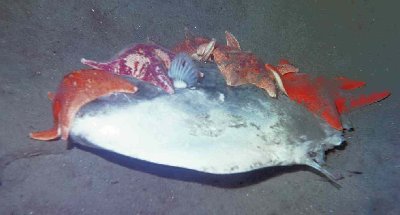
Other things we came across were Giant Sun Starfish, a Sheep crab eating a Purple Jellyfish, and some other small crab I have seen on the beach but don't know what it is. Towards the end of the dive we got buzzed by a California Sea Lion. If only I were that graceful and well insulated!
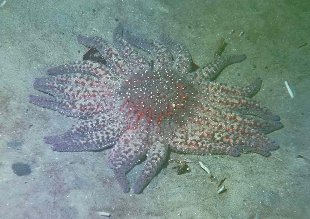

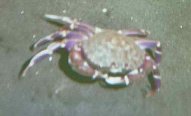
All in all, a great introduction to the cold Pacific. I hope to get back some time to explore some more, and highly recommend that anyone who hasn't done it try it. The kelp forests are truly magical if the visibility is good enough.
We were fortunate with the weather and the sea conditions; the next day there were big swells, up to 18 feet, with breakers on shore 12-16 feet high.